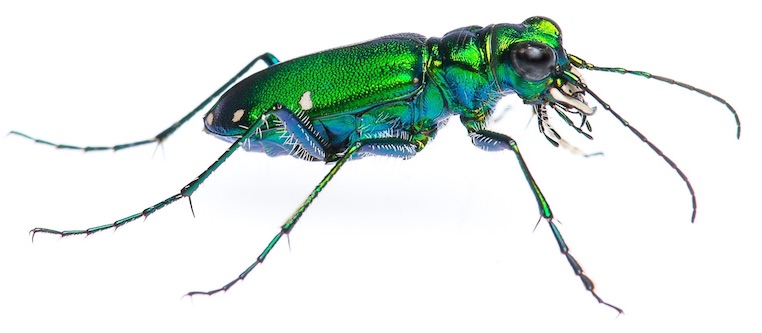Taxonomy
Family: CARABIDAE
Subfamily: CicindelinaeSubgenus: Cicindela Comments: One of 38 species in this genus that occur in North America north of Mexico (Pearson et al., 2015), 12 of which have been recorded in North CarolinaSpecies Status: Two subspecies have been described, of which only the nominate form occurs in North Carolina (Pearson et al., 2015)
Identification
Distribution in North Carolina
County Map: Clicking on a county returns the records for the species in that county.
Flight Dates: Click on graph to enlarge
Habitats and Life History
Habitats: This species is associated with dry sandy soils, often in association with substrates formed from erosion of rock outcrops. Outside of North Carolina, it is often found around outcrops of sandstone. Sedimentary formations such as sandstone are rare, however, in North Carolina, but our one recent record comes from a granitic dome, which supports barrens vegetation composed of pines, stunted oaks, mosses and lichens, all of which are consistent with habitats used elsewhere within its range (Knisley and Schultz, 1997; Pearson et al., 2015). Diet: Predacious, presumably feeding on a wide variety of small insects and other arthropodsObservation Methods: The green color of this species is conspicuous when it is crossing bare rock but may serve as camouflage when it is located amidst mosses and lichens (Knisley and Schultz, 1997). Abundance/Frequency: Adult Phenology:
Status in North Carolina
Natural Heritage Program Status: SRNatural Heritage Program Ranks: G3T3 [S2S3] State Protection: This species is listed as Significantly Rare by the North Carolina Natural Heritage Program, which gives it some value in identifying priority natural areas for conservation but does not give it any sort of legal protection. Nor is protection provided by either the Federal or State Endangered Species Acts. While all species are eligible for federal protection, the populations of this species are still considered relatively secure at the national level, and in the case of North Carolina endangered species protection, no insects even qualify for statewide protection no matter how endangered they might be within the state. This is markedly different from the case of vertebrates, molluscs, or crustaceans, all of which may receive protection from hunting, collection, or other forms of exploitation depending on their state conservation status. Individual state agencies -- such as the Division of Parks and Recreation and Wildlife Resources Commission -- can nonetheless require permits for collecting insects on lands they own or manage. The same is true for other types of nature preserves.Comments: This species is a strong habitat specialist and naturally occurs in fairly widely disjunct populations. We have very few records for this species in North Carolina, including only one recent record. Searches need to be made of granitic domes throughout our mountains in order to more accurately determine its status. Efforts should be made to avoid the trampling effects of human traffic in areas where larvae are likely to occur.
Photo Gallery for Cicindela patruela - Northern Barrens Tiger Beetle Recorded by: Clark D. Tew Recorded by: Clark D. Tew Recorded by: Mark Shields Recorded by: Ed Corey Recorded by: E. Corey Recorded by: E. Corey Recorded by: Patrick Cooney, Byron Levan, Janet Pearson

 »
»
 »
»